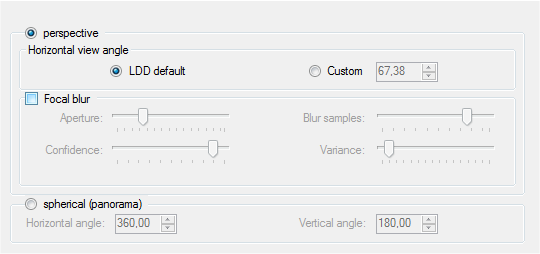Camera
The camera tab contains setting for the POV-Ray™ camera.
Perspective camera
This is the camera type used by LDD. When POV-Ray™ uses this camera, result is picture similar to LDD screenshot. Precondition is to render using output resolution having the same aspect ratio as is the screen resolution - for example when screen resolution is 800x600, rendering output resolution should also have aspect ratio 800:600 = 4:3. So rendering should be done at 200x150, 800x600, 1000x750 or similar maintaining the aspect ratio 4:3. When aspect ration is not maintained, visible portion of the model will be different than in LDD.
This type of camera has several characteristics:
Horizontal view angle
View angle determines how wide area of the scene is seen by camera and also how deep is the perspective. LDD uses view angle which corresponds to approximately 25°. This view angle gives not so deep perspective view. When deeper perspective angle is needed use custom camera view angle.
Note: LDD to POV-Ray™ Converter recalculates position of the camera to keep approximately the same area of the model in the view, but it is not accurate so some test renders are recommended before running final render.
Focal blur
Focal blur in the POV-Ray™ uses 4 main parameters which have an influence on the focal blur appearance in the final output image.
Aperture
This value determines how much blurred is the image - or how wide is the zone of sharpness. Smaller values produce sharper image with wide zone of sharpness, larger values result in more blurred image. Generally, on a real photography, close-up pictures showing details have more focal blur present and this means, that such rendered images need higher aperture values.
Blur samples
To simulate focal blur POV-Ray takes additional rays for each rendered pixel. Blur samples controls how many additional rays are used. The more rays, the higher output quality and more realistic focal blur appearance but also longer rendering time.
Confidence and Variance
These two parameters control the adaptive process of spawning additional rays. Blur samples represents maximum number of rays, but POV-Ray™ stops spawning new rays as soon as the calculated pixel color differs less than variance with a certain confidence. Higher confidence leads to higher quality but also means, that adaptive process will probably take all blur samples and therefore rendering will take longer.
Spherical (panoramatic) camera
This special type of camera is useful to create HDR images useful for lighting and reflections during rendering of other models. Good example is a castle yard. Camera placed in the center of a square castle yard will generated full 360° view image of the whole castle and yard and when used for other models as sky sphere image, it will look like the model was photographed in the center of that castle yard.